Networking Technologies Report: Network Design for Beta Communication
VerifiedAdded on 2023/03/30
|38
|6945
|394
Report
AI Summary
This report provides a comprehensive analysis of networking technologies, focusing on the design and implementation of a Local Area Network (LAN) for Beta Communication, a company with multiple buildings. The report begins by discussing various networking systems, including Personal Area Networks (PANs), LANs, Metropolitan Area Networks (MANs), Wide Area Networks (WANs), and cloud networking, alongside their benefits and constraints. It then delves into the requirements of Beta Communication, advocating for a LAN topology to connect its three buildings, considering factors like security, speed, and scalability. The report evaluates the impact of current network technologies, communication standards, and protocols, including a detailed examination of hardware and software components, server types, and workstation-network interdependence. It outlines a hierarchical LAN design, encompassing access and distribution layers, and proposes a network implementation plan. The report concludes with network testing, documentation of results, recommendations for enhancements, and a proposed maintenance schedule to ensure network efficiency and reliability. This comprehensive analysis is designed to guide the effective establishment and management of a robust network infrastructure for Beta Communication.

Networking Technologies 1
Networking Technologies
Student's Name:
Instructor's Name:
Date:
Networking Technologies
Student's Name:
Instructor's Name:
Date:
Paraphrase This Document
Need a fresh take? Get an instant paraphrase of this document with our AI Paraphraser
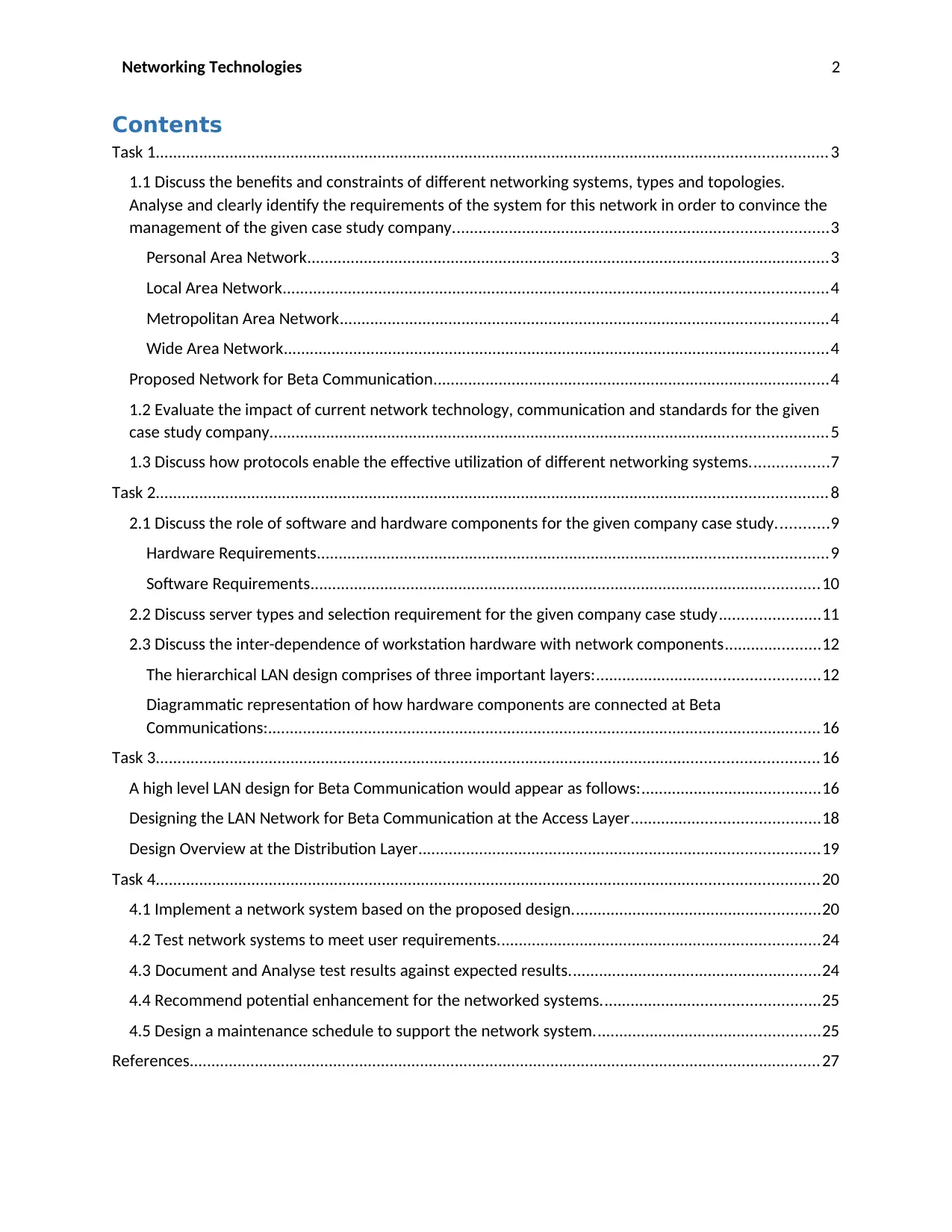
Networking Technologies 2
Contents
Task 1..........................................................................................................................................................3
1.1 Discuss the benefits and constraints of different networking systems, types and topologies.
Analyse and clearly identify the requirements of the system for this network in order to convince the
management of the given case study company......................................................................................3
Personal Area Network........................................................................................................................3
Local Area Network.............................................................................................................................4
Metropolitan Area Network................................................................................................................4
Wide Area Network.............................................................................................................................4
Proposed Network for Beta Communication...........................................................................................4
1.2 Evaluate the impact of current network technology, communication and standards for the given
case study company................................................................................................................................5
1.3 Discuss how protocols enable the effective utilization of different networking systems..................7
Task 2..........................................................................................................................................................8
2.1 Discuss the role of software and hardware components for the given company case study............9
Hardware Requirements.....................................................................................................................9
Software Requirements.....................................................................................................................10
2.2 Discuss server types and selection requirement for the given company case study.......................11
2.3 Discuss the inter-dependence of workstation hardware with network components......................12
The hierarchical LAN design comprises of three important layers:...................................................12
Diagrammatic representation of how hardware components are connected at Beta
Communications:...............................................................................................................................16
Task 3........................................................................................................................................................16
A high level LAN design for Beta Communication would appear as follows:.........................................16
Designing the LAN Network for Beta Communication at the Access Layer...........................................18
Design Overview at the Distribution Layer............................................................................................19
Task 4........................................................................................................................................................20
4.1 Implement a network system based on the proposed design.........................................................20
4.2 Test network systems to meet user requirements..........................................................................24
4.3 Document and Analyse test results against expected results..........................................................24
4.4 Recommend potential enhancement for the networked systems..................................................25
4.5 Design a maintenance schedule to support the network system....................................................25
References.................................................................................................................................................27
Contents
Task 1..........................................................................................................................................................3
1.1 Discuss the benefits and constraints of different networking systems, types and topologies.
Analyse and clearly identify the requirements of the system for this network in order to convince the
management of the given case study company......................................................................................3
Personal Area Network........................................................................................................................3
Local Area Network.............................................................................................................................4
Metropolitan Area Network................................................................................................................4
Wide Area Network.............................................................................................................................4
Proposed Network for Beta Communication...........................................................................................4
1.2 Evaluate the impact of current network technology, communication and standards for the given
case study company................................................................................................................................5
1.3 Discuss how protocols enable the effective utilization of different networking systems..................7
Task 2..........................................................................................................................................................8
2.1 Discuss the role of software and hardware components for the given company case study............9
Hardware Requirements.....................................................................................................................9
Software Requirements.....................................................................................................................10
2.2 Discuss server types and selection requirement for the given company case study.......................11
2.3 Discuss the inter-dependence of workstation hardware with network components......................12
The hierarchical LAN design comprises of three important layers:...................................................12
Diagrammatic representation of how hardware components are connected at Beta
Communications:...............................................................................................................................16
Task 3........................................................................................................................................................16
A high level LAN design for Beta Communication would appear as follows:.........................................16
Designing the LAN Network for Beta Communication at the Access Layer...........................................18
Design Overview at the Distribution Layer............................................................................................19
Task 4........................................................................................................................................................20
4.1 Implement a network system based on the proposed design.........................................................20
4.2 Test network systems to meet user requirements..........................................................................24
4.3 Document and Analyse test results against expected results..........................................................24
4.4 Recommend potential enhancement for the networked systems..................................................25
4.5 Design a maintenance schedule to support the network system....................................................25
References.................................................................................................................................................27
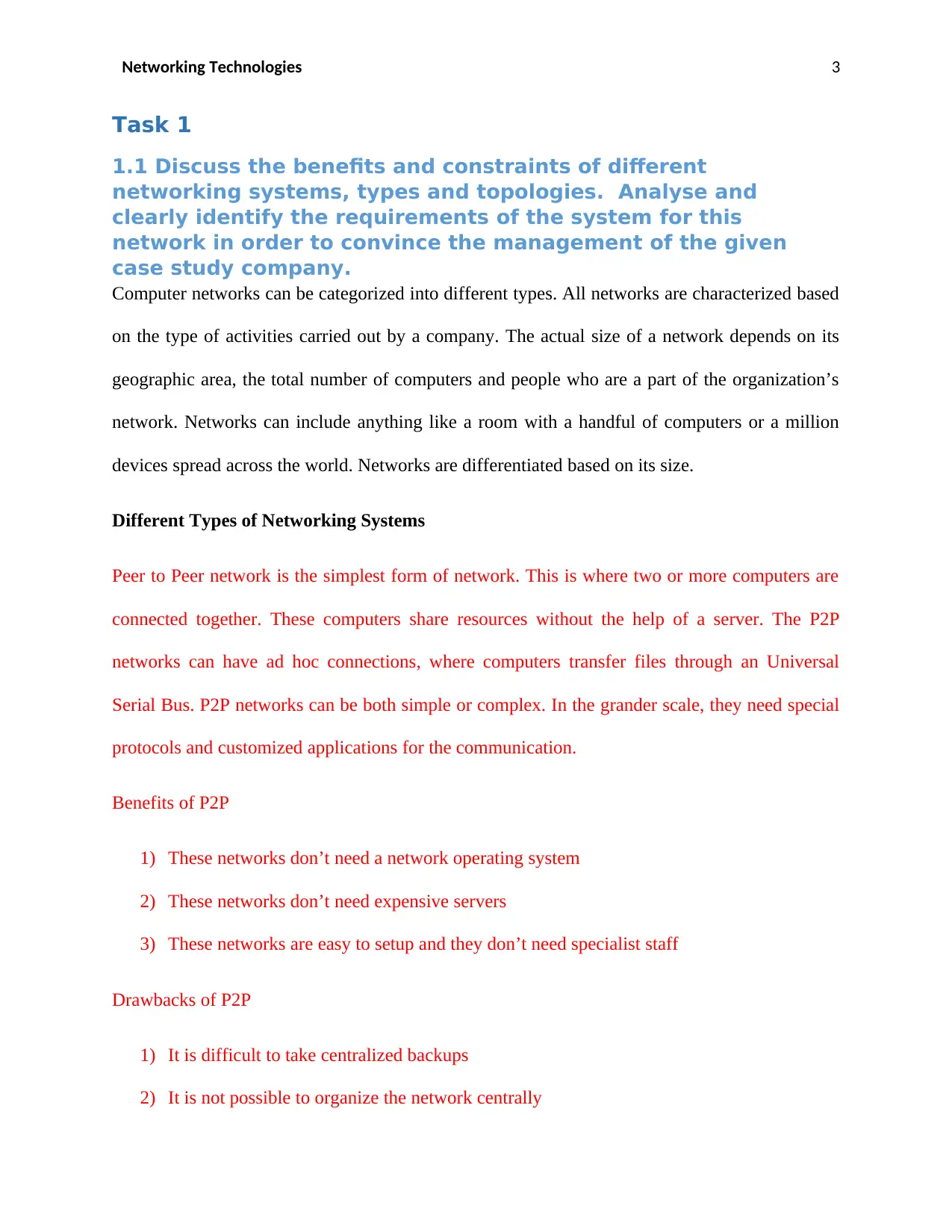
Networking Technologies 3
Task 1
1.1 Discuss the benefits and constraints of different
networking systems, types and topologies. Analyse and
clearly identify the requirements of the system for this
network in order to convince the management of the given
case study company.
Computer networks can be categorized into different types. All networks are characterized based
on the type of activities carried out by a company. The actual size of a network depends on its
geographic area, the total number of computers and people who are a part of the organization’s
network. Networks can include anything like a room with a handful of computers or a million
devices spread across the world. Networks are differentiated based on its size.
Different Types of Networking Systems
Peer to Peer network is the simplest form of network. This is where two or more computers are
connected together. These computers share resources without the help of a server. The P2P
networks can have ad hoc connections, where computers transfer files through an Universal
Serial Bus. P2P networks can be both simple or complex. In the grander scale, they need special
protocols and customized applications for the communication.
Benefits of P2P
1) These networks don’t need a network operating system
2) These networks don’t need expensive servers
3) These networks are easy to setup and they don’t need specialist staff
Drawbacks of P2P
1) It is difficult to take centralized backups
2) It is not possible to organize the network centrally
Task 1
1.1 Discuss the benefits and constraints of different
networking systems, types and topologies. Analyse and
clearly identify the requirements of the system for this
network in order to convince the management of the given
case study company.
Computer networks can be categorized into different types. All networks are characterized based
on the type of activities carried out by a company. The actual size of a network depends on its
geographic area, the total number of computers and people who are a part of the organization’s
network. Networks can include anything like a room with a handful of computers or a million
devices spread across the world. Networks are differentiated based on its size.
Different Types of Networking Systems
Peer to Peer network is the simplest form of network. This is where two or more computers are
connected together. These computers share resources without the help of a server. The P2P
networks can have ad hoc connections, where computers transfer files through an Universal
Serial Bus. P2P networks can be both simple or complex. In the grander scale, they need special
protocols and customized applications for the communication.
Benefits of P2P
1) These networks don’t need a network operating system
2) These networks don’t need expensive servers
3) These networks are easy to setup and they don’t need specialist staff
Drawbacks of P2P
1) It is difficult to take centralized backups
2) It is not possible to organize the network centrally
⊘ This is a preview!⊘
Do you want full access?
Subscribe today to unlock all pages.

Trusted by 1+ million students worldwide
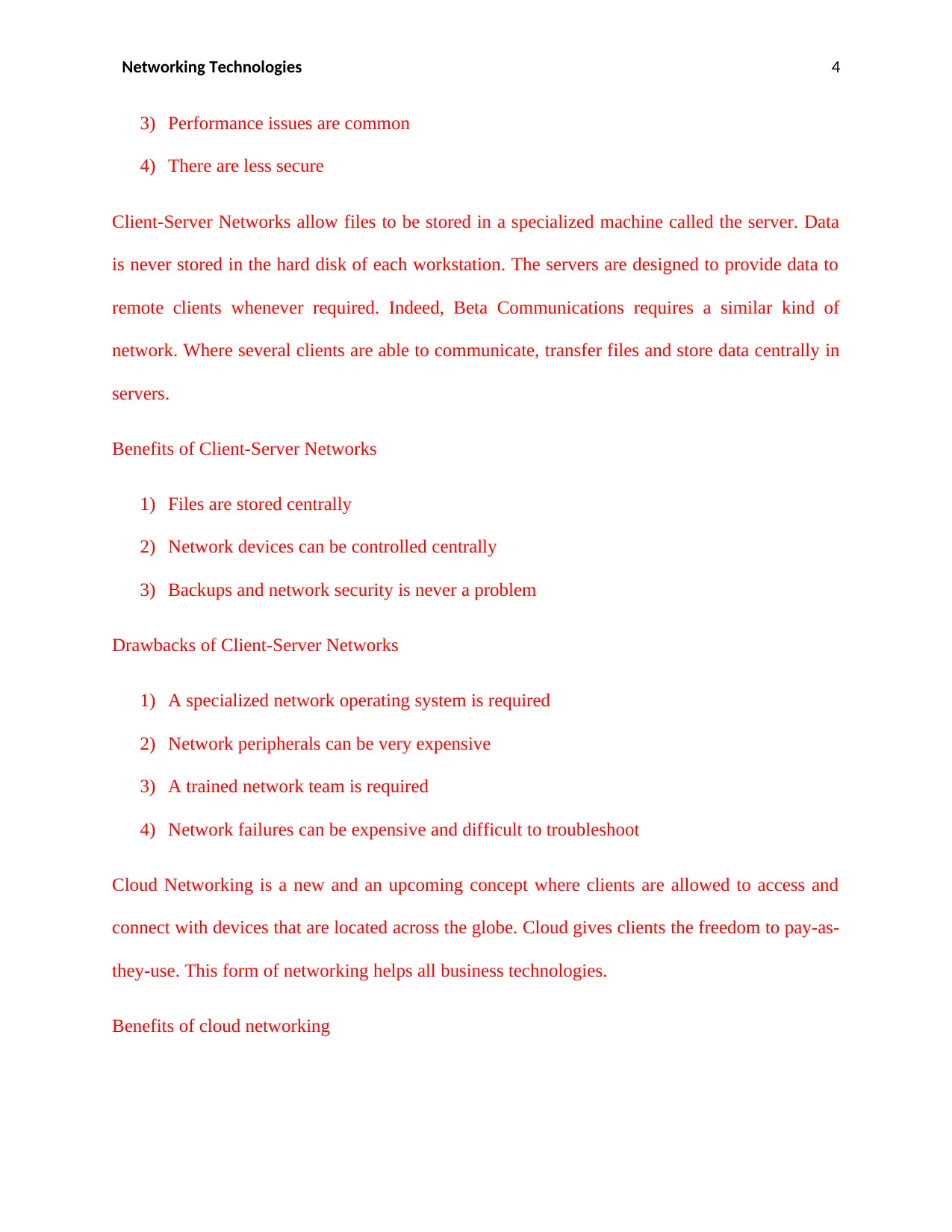
Networking Technologies 4
3) Performance issues are common
4) There are less secure
Client-Server Networks allow files to be stored in a specialized machine called the server. Data
is never stored in the hard disk of each workstation. The servers are designed to provide data to
remote clients whenever required. Indeed, Beta Communications requires a similar kind of
network. Where several clients are able to communicate, transfer files and store data centrally in
servers.
Benefits of Client-Server Networks
1) Files are stored centrally
2) Network devices can be controlled centrally
3) Backups and network security is never a problem
Drawbacks of Client-Server Networks
1) A specialized network operating system is required
2) Network peripherals can be very expensive
3) A trained network team is required
4) Network failures can be expensive and difficult to troubleshoot
Cloud Networking is a new and an upcoming concept where clients are allowed to access and
connect with devices that are located across the globe. Cloud gives clients the freedom to pay-as-
they-use. This form of networking helps all business technologies.
Benefits of cloud networking
3) Performance issues are common
4) There are less secure
Client-Server Networks allow files to be stored in a specialized machine called the server. Data
is never stored in the hard disk of each workstation. The servers are designed to provide data to
remote clients whenever required. Indeed, Beta Communications requires a similar kind of
network. Where several clients are able to communicate, transfer files and store data centrally in
servers.
Benefits of Client-Server Networks
1) Files are stored centrally
2) Network devices can be controlled centrally
3) Backups and network security is never a problem
Drawbacks of Client-Server Networks
1) A specialized network operating system is required
2) Network peripherals can be very expensive
3) A trained network team is required
4) Network failures can be expensive and difficult to troubleshoot
Cloud Networking is a new and an upcoming concept where clients are allowed to access and
connect with devices that are located across the globe. Cloud gives clients the freedom to pay-as-
they-use. This form of networking helps all business technologies.
Benefits of cloud networking
Paraphrase This Document
Need a fresh take? Get an instant paraphrase of this document with our AI Paraphraser
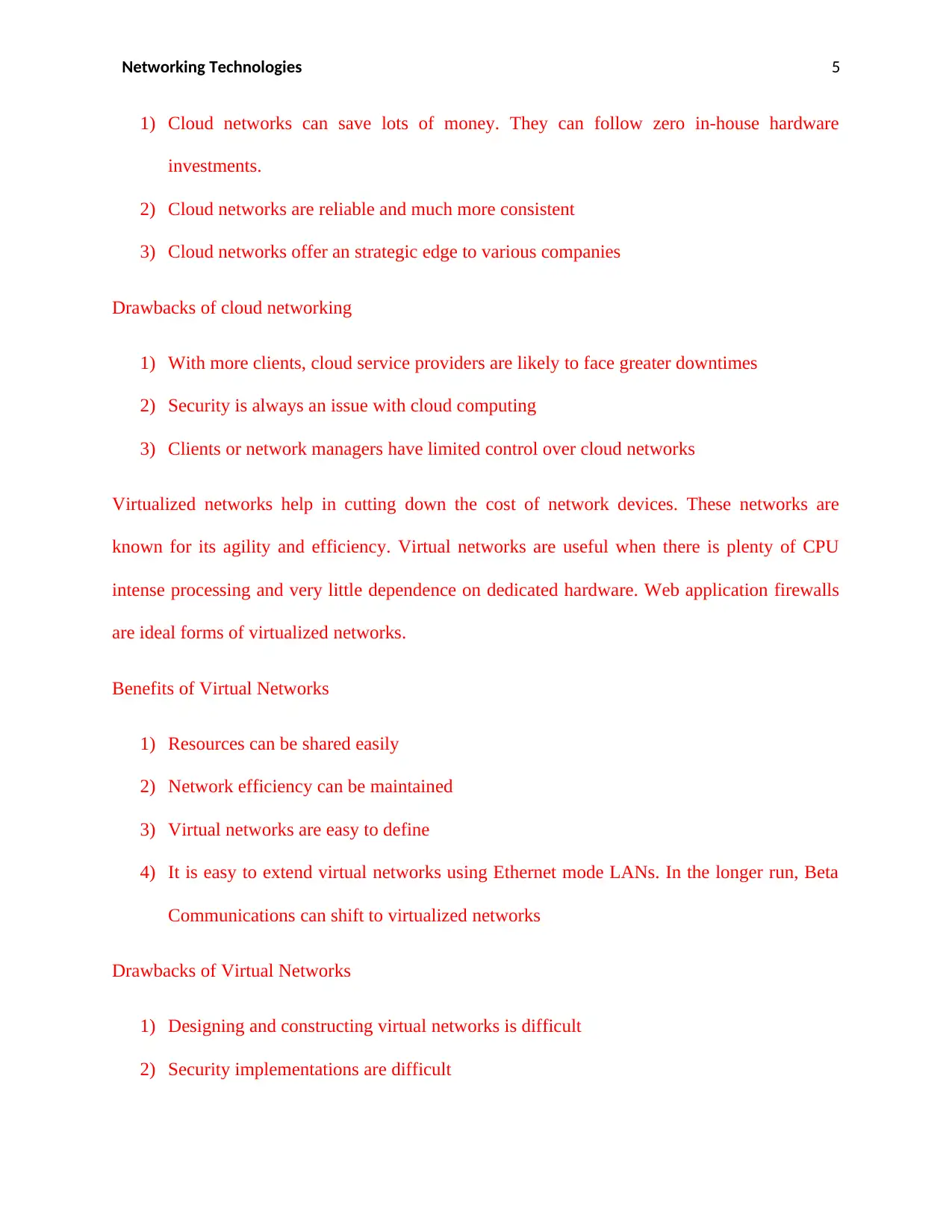
Networking Technologies 5
1) Cloud networks can save lots of money. They can follow zero in-house hardware
investments.
2) Cloud networks are reliable and much more consistent
3) Cloud networks offer an strategic edge to various companies
Drawbacks of cloud networking
1) With more clients, cloud service providers are likely to face greater downtimes
2) Security is always an issue with cloud computing
3) Clients or network managers have limited control over cloud networks
Virtualized networks help in cutting down the cost of network devices. These networks are
known for its agility and efficiency. Virtual networks are useful when there is plenty of CPU
intense processing and very little dependence on dedicated hardware. Web application firewalls
are ideal forms of virtualized networks.
Benefits of Virtual Networks
1) Resources can be shared easily
2) Network efficiency can be maintained
3) Virtual networks are easy to define
4) It is easy to extend virtual networks using Ethernet mode LANs. In the longer run, Beta
Communications can shift to virtualized networks
Drawbacks of Virtual Networks
1) Designing and constructing virtual networks is difficult
2) Security implementations are difficult
1) Cloud networks can save lots of money. They can follow zero in-house hardware
investments.
2) Cloud networks are reliable and much more consistent
3) Cloud networks offer an strategic edge to various companies
Drawbacks of cloud networking
1) With more clients, cloud service providers are likely to face greater downtimes
2) Security is always an issue with cloud computing
3) Clients or network managers have limited control over cloud networks
Virtualized networks help in cutting down the cost of network devices. These networks are
known for its agility and efficiency. Virtual networks are useful when there is plenty of CPU
intense processing and very little dependence on dedicated hardware. Web application firewalls
are ideal forms of virtualized networks.
Benefits of Virtual Networks
1) Resources can be shared easily
2) Network efficiency can be maintained
3) Virtual networks are easy to define
4) It is easy to extend virtual networks using Ethernet mode LANs. In the longer run, Beta
Communications can shift to virtualized networks
Drawbacks of Virtual Networks
1) Designing and constructing virtual networks is difficult
2) Security implementations are difficult
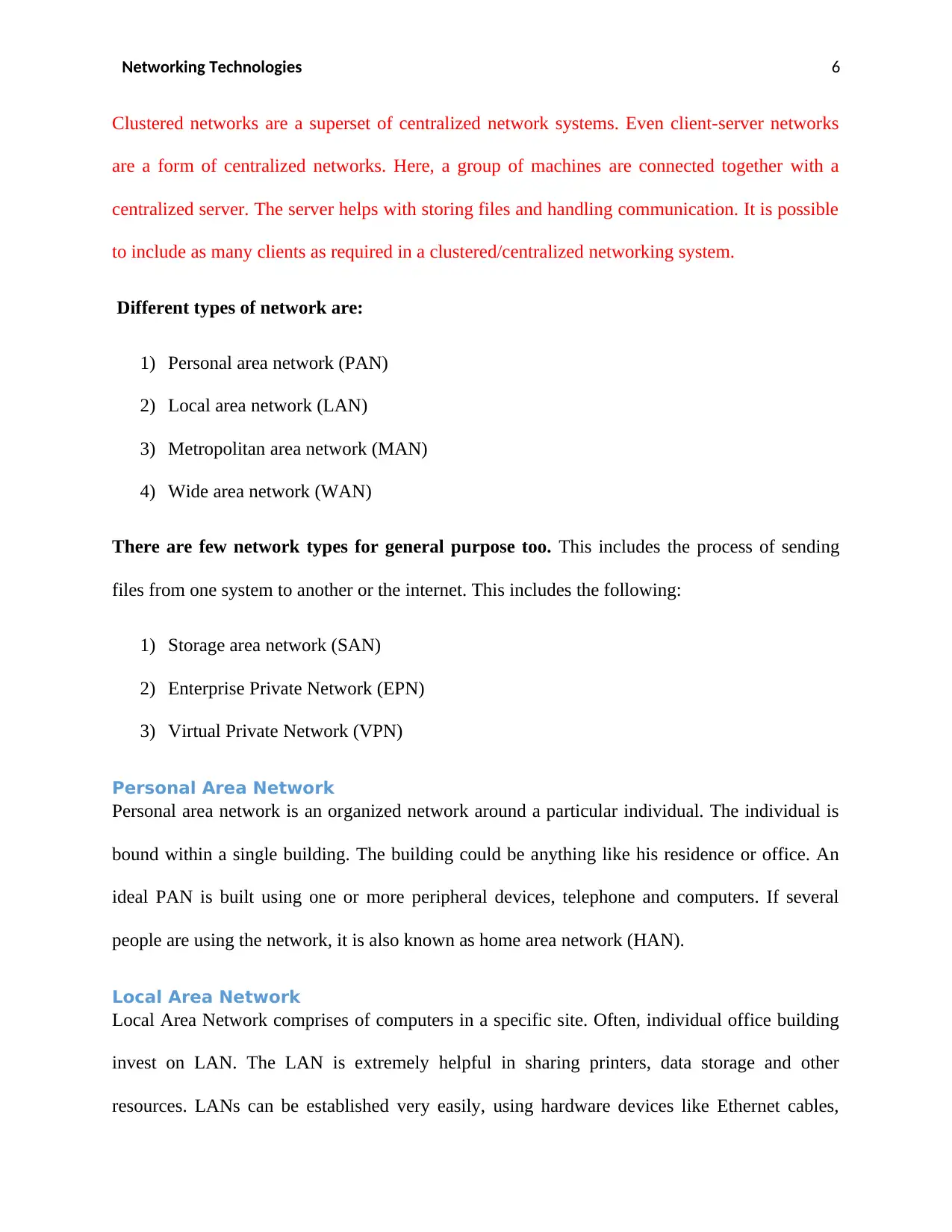
Networking Technologies 6
Clustered networks are a superset of centralized network systems. Even client-server networks
are a form of centralized networks. Here, a group of machines are connected together with a
centralized server. The server helps with storing files and handling communication. It is possible
to include as many clients as required in a clustered/centralized networking system.
Different types of network are:
1) Personal area network (PAN)
2) Local area network (LAN)
3) Metropolitan area network (MAN)
4) Wide area network (WAN)
There are few network types for general purpose too. This includes the process of sending
files from one system to another or the internet. This includes the following:
1) Storage area network (SAN)
2) Enterprise Private Network (EPN)
3) Virtual Private Network (VPN)
Personal Area Network
Personal area network is an organized network around a particular individual. The individual is
bound within a single building. The building could be anything like his residence or office. An
ideal PAN is built using one or more peripheral devices, telephone and computers. If several
people are using the network, it is also known as home area network (HAN).
Local Area Network
Local Area Network comprises of computers in a specific site. Often, individual office building
invest on LAN. The LAN is extremely helpful in sharing printers, data storage and other
resources. LANs can be established very easily, using hardware devices like Ethernet cables,
Clustered networks are a superset of centralized network systems. Even client-server networks
are a form of centralized networks. Here, a group of machines are connected together with a
centralized server. The server helps with storing files and handling communication. It is possible
to include as many clients as required in a clustered/centralized networking system.
Different types of network are:
1) Personal area network (PAN)
2) Local area network (LAN)
3) Metropolitan area network (MAN)
4) Wide area network (WAN)
There are few network types for general purpose too. This includes the process of sending
files from one system to another or the internet. This includes the following:
1) Storage area network (SAN)
2) Enterprise Private Network (EPN)
3) Virtual Private Network (VPN)
Personal Area Network
Personal area network is an organized network around a particular individual. The individual is
bound within a single building. The building could be anything like his residence or office. An
ideal PAN is built using one or more peripheral devices, telephone and computers. If several
people are using the network, it is also known as home area network (HAN).
Local Area Network
Local Area Network comprises of computers in a specific site. Often, individual office building
invest on LAN. The LAN is extremely helpful in sharing printers, data storage and other
resources. LANs can be established very easily, using hardware devices like Ethernet cables,
⊘ This is a preview!⊘
Do you want full access?
Subscribe today to unlock all pages.

Trusted by 1+ million students worldwide
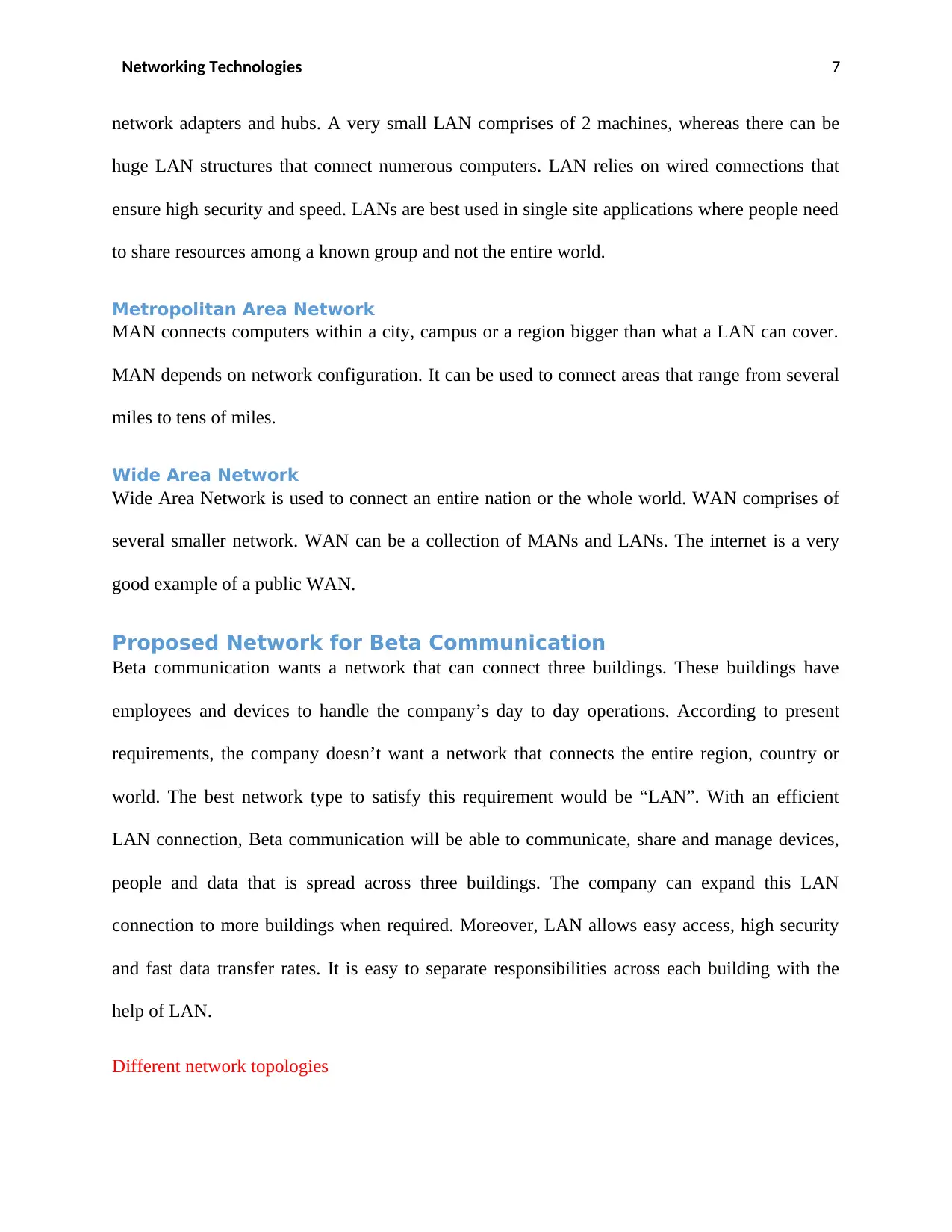
Networking Technologies 7
network adapters and hubs. A very small LAN comprises of 2 machines, whereas there can be
huge LAN structures that connect numerous computers. LAN relies on wired connections that
ensure high security and speed. LANs are best used in single site applications where people need
to share resources among a known group and not the entire world.
Metropolitan Area Network
MAN connects computers within a city, campus or a region bigger than what a LAN can cover.
MAN depends on network configuration. It can be used to connect areas that range from several
miles to tens of miles.
Wide Area Network
Wide Area Network is used to connect an entire nation or the whole world. WAN comprises of
several smaller network. WAN can be a collection of MANs and LANs. The internet is a very
good example of a public WAN.
Proposed Network for Beta Communication
Beta communication wants a network that can connect three buildings. These buildings have
employees and devices to handle the company’s day to day operations. According to present
requirements, the company doesn’t want a network that connects the entire region, country or
world. The best network type to satisfy this requirement would be “LAN”. With an efficient
LAN connection, Beta communication will be able to communicate, share and manage devices,
people and data that is spread across three buildings. The company can expand this LAN
connection to more buildings when required. Moreover, LAN allows easy access, high security
and fast data transfer rates. It is easy to separate responsibilities across each building with the
help of LAN.
Different network topologies
network adapters and hubs. A very small LAN comprises of 2 machines, whereas there can be
huge LAN structures that connect numerous computers. LAN relies on wired connections that
ensure high security and speed. LANs are best used in single site applications where people need
to share resources among a known group and not the entire world.
Metropolitan Area Network
MAN connects computers within a city, campus or a region bigger than what a LAN can cover.
MAN depends on network configuration. It can be used to connect areas that range from several
miles to tens of miles.
Wide Area Network
Wide Area Network is used to connect an entire nation or the whole world. WAN comprises of
several smaller network. WAN can be a collection of MANs and LANs. The internet is a very
good example of a public WAN.
Proposed Network for Beta Communication
Beta communication wants a network that can connect three buildings. These buildings have
employees and devices to handle the company’s day to day operations. According to present
requirements, the company doesn’t want a network that connects the entire region, country or
world. The best network type to satisfy this requirement would be “LAN”. With an efficient
LAN connection, Beta communication will be able to communicate, share and manage devices,
people and data that is spread across three buildings. The company can expand this LAN
connection to more buildings when required. Moreover, LAN allows easy access, high security
and fast data transfer rates. It is easy to separate responsibilities across each building with the
help of LAN.
Different network topologies
Paraphrase This Document
Need a fresh take? Get an instant paraphrase of this document with our AI Paraphraser
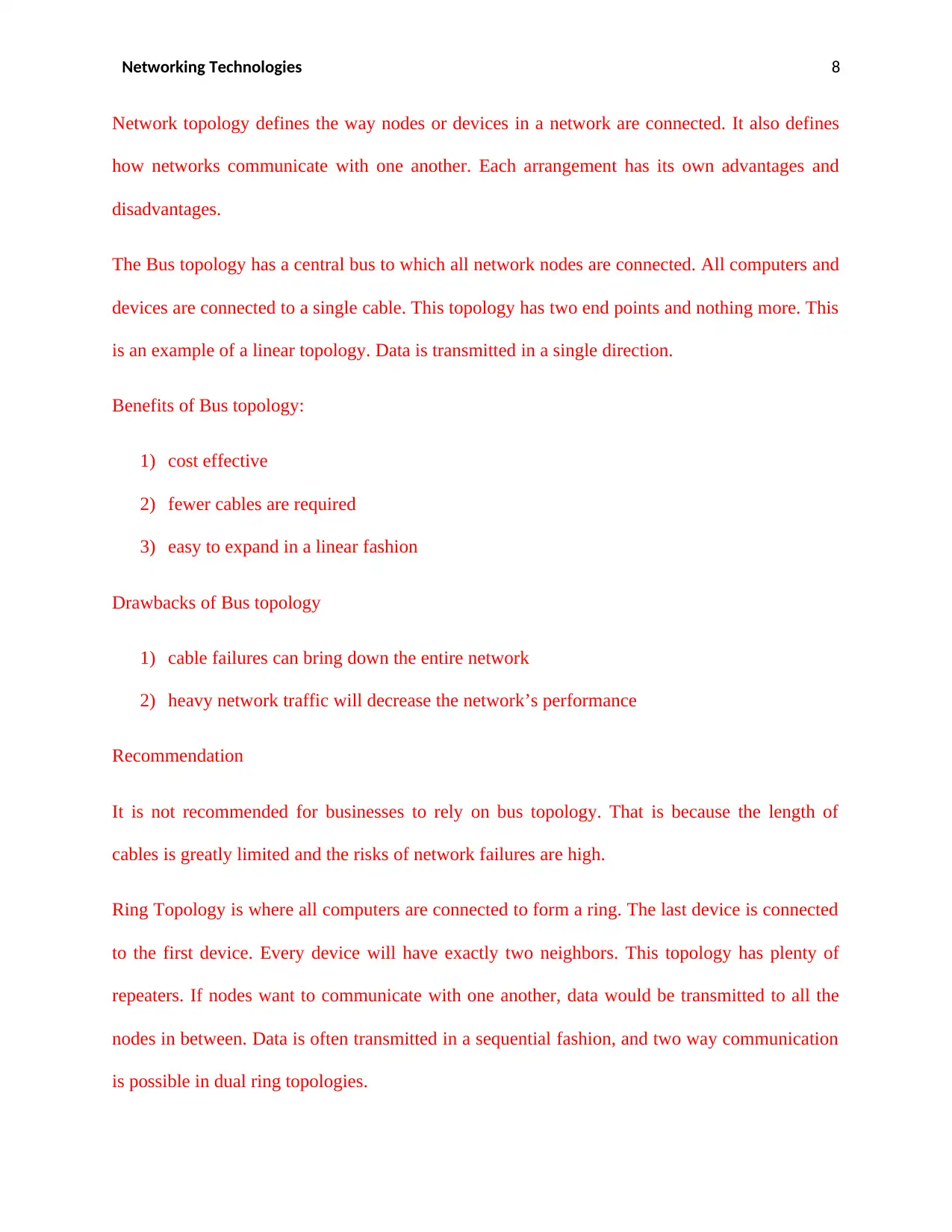
Networking Technologies 8
Network topology defines the way nodes or devices in a network are connected. It also defines
how networks communicate with one another. Each arrangement has its own advantages and
disadvantages.
The Bus topology has a central bus to which all network nodes are connected. All computers and
devices are connected to a single cable. This topology has two end points and nothing more. This
is an example of a linear topology. Data is transmitted in a single direction.
Benefits of Bus topology:
1) cost effective
2) fewer cables are required
3) easy to expand in a linear fashion
Drawbacks of Bus topology
1) cable failures can bring down the entire network
2) heavy network traffic will decrease the network’s performance
Recommendation
It is not recommended for businesses to rely on bus topology. That is because the length of
cables is greatly limited and the risks of network failures are high.
Ring Topology is where all computers are connected to form a ring. The last device is connected
to the first device. Every device will have exactly two neighbors. This topology has plenty of
repeaters. If nodes want to communicate with one another, data would be transmitted to all the
nodes in between. Data is often transmitted in a sequential fashion, and two way communication
is possible in dual ring topologies.
Network topology defines the way nodes or devices in a network are connected. It also defines
how networks communicate with one another. Each arrangement has its own advantages and
disadvantages.
The Bus topology has a central bus to which all network nodes are connected. All computers and
devices are connected to a single cable. This topology has two end points and nothing more. This
is an example of a linear topology. Data is transmitted in a single direction.
Benefits of Bus topology:
1) cost effective
2) fewer cables are required
3) easy to expand in a linear fashion
Drawbacks of Bus topology
1) cable failures can bring down the entire network
2) heavy network traffic will decrease the network’s performance
Recommendation
It is not recommended for businesses to rely on bus topology. That is because the length of
cables is greatly limited and the risks of network failures are high.
Ring Topology is where all computers are connected to form a ring. The last device is connected
to the first device. Every device will have exactly two neighbors. This topology has plenty of
repeaters. If nodes want to communicate with one another, data would be transmitted to all the
nodes in between. Data is often transmitted in a sequential fashion, and two way communication
is possible in dual ring topologies.
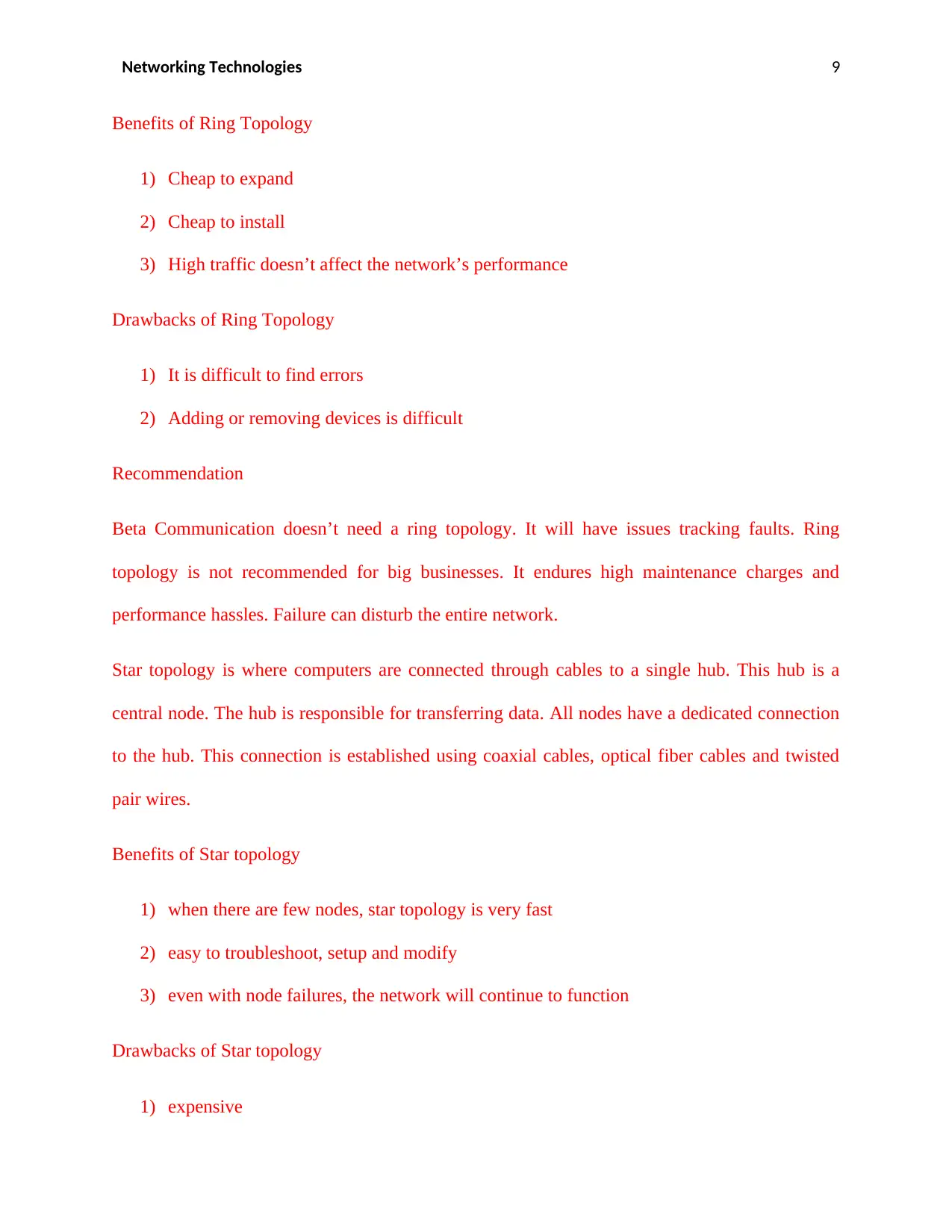
Networking Technologies 9
Benefits of Ring Topology
1) Cheap to expand
2) Cheap to install
3) High traffic doesn’t affect the network’s performance
Drawbacks of Ring Topology
1) It is difficult to find errors
2) Adding or removing devices is difficult
Recommendation
Beta Communication doesn’t need a ring topology. It will have issues tracking faults. Ring
topology is not recommended for big businesses. It endures high maintenance charges and
performance hassles. Failure can disturb the entire network.
Star topology is where computers are connected through cables to a single hub. This hub is a
central node. The hub is responsible for transferring data. All nodes have a dedicated connection
to the hub. This connection is established using coaxial cables, optical fiber cables and twisted
pair wires.
Benefits of Star topology
1) when there are few nodes, star topology is very fast
2) easy to troubleshoot, setup and modify
3) even with node failures, the network will continue to function
Drawbacks of Star topology
1) expensive
Benefits of Ring Topology
1) Cheap to expand
2) Cheap to install
3) High traffic doesn’t affect the network’s performance
Drawbacks of Ring Topology
1) It is difficult to find errors
2) Adding or removing devices is difficult
Recommendation
Beta Communication doesn’t need a ring topology. It will have issues tracking faults. Ring
topology is not recommended for big businesses. It endures high maintenance charges and
performance hassles. Failure can disturb the entire network.
Star topology is where computers are connected through cables to a single hub. This hub is a
central node. The hub is responsible for transferring data. All nodes have a dedicated connection
to the hub. This connection is established using coaxial cables, optical fiber cables and twisted
pair wires.
Benefits of Star topology
1) when there are few nodes, star topology is very fast
2) easy to troubleshoot, setup and modify
3) even with node failures, the network will continue to function
Drawbacks of Star topology
1) expensive
⊘ This is a preview!⊘
Do you want full access?
Subscribe today to unlock all pages.

Trusted by 1+ million students worldwide
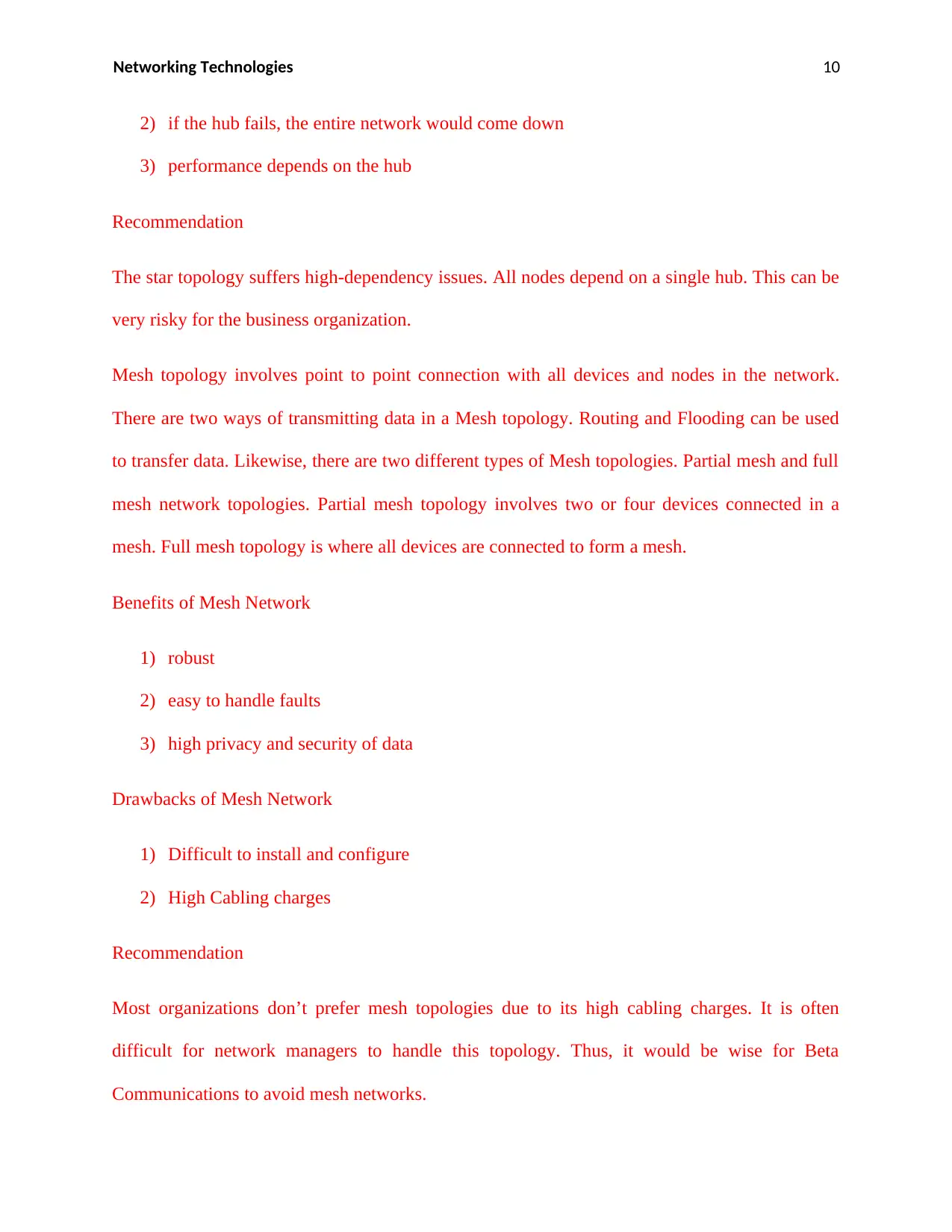
Networking Technologies 10
2) if the hub fails, the entire network would come down
3) performance depends on the hub
Recommendation
The star topology suffers high-dependency issues. All nodes depend on a single hub. This can be
very risky for the business organization.
Mesh topology involves point to point connection with all devices and nodes in the network.
There are two ways of transmitting data in a Mesh topology. Routing and Flooding can be used
to transfer data. Likewise, there are two different types of Mesh topologies. Partial mesh and full
mesh network topologies. Partial mesh topology involves two or four devices connected in a
mesh. Full mesh topology is where all devices are connected to form a mesh.
Benefits of Mesh Network
1) robust
2) easy to handle faults
3) high privacy and security of data
Drawbacks of Mesh Network
1) Difficult to install and configure
2) High Cabling charges
Recommendation
Most organizations don’t prefer mesh topologies due to its high cabling charges. It is often
difficult for network managers to handle this topology. Thus, it would be wise for Beta
Communications to avoid mesh networks.
2) if the hub fails, the entire network would come down
3) performance depends on the hub
Recommendation
The star topology suffers high-dependency issues. All nodes depend on a single hub. This can be
very risky for the business organization.
Mesh topology involves point to point connection with all devices and nodes in the network.
There are two ways of transmitting data in a Mesh topology. Routing and Flooding can be used
to transfer data. Likewise, there are two different types of Mesh topologies. Partial mesh and full
mesh network topologies. Partial mesh topology involves two or four devices connected in a
mesh. Full mesh topology is where all devices are connected to form a mesh.
Benefits of Mesh Network
1) robust
2) easy to handle faults
3) high privacy and security of data
Drawbacks of Mesh Network
1) Difficult to install and configure
2) High Cabling charges
Recommendation
Most organizations don’t prefer mesh topologies due to its high cabling charges. It is often
difficult for network managers to handle this topology. Thus, it would be wise for Beta
Communications to avoid mesh networks.
Paraphrase This Document
Need a fresh take? Get an instant paraphrase of this document with our AI Paraphraser
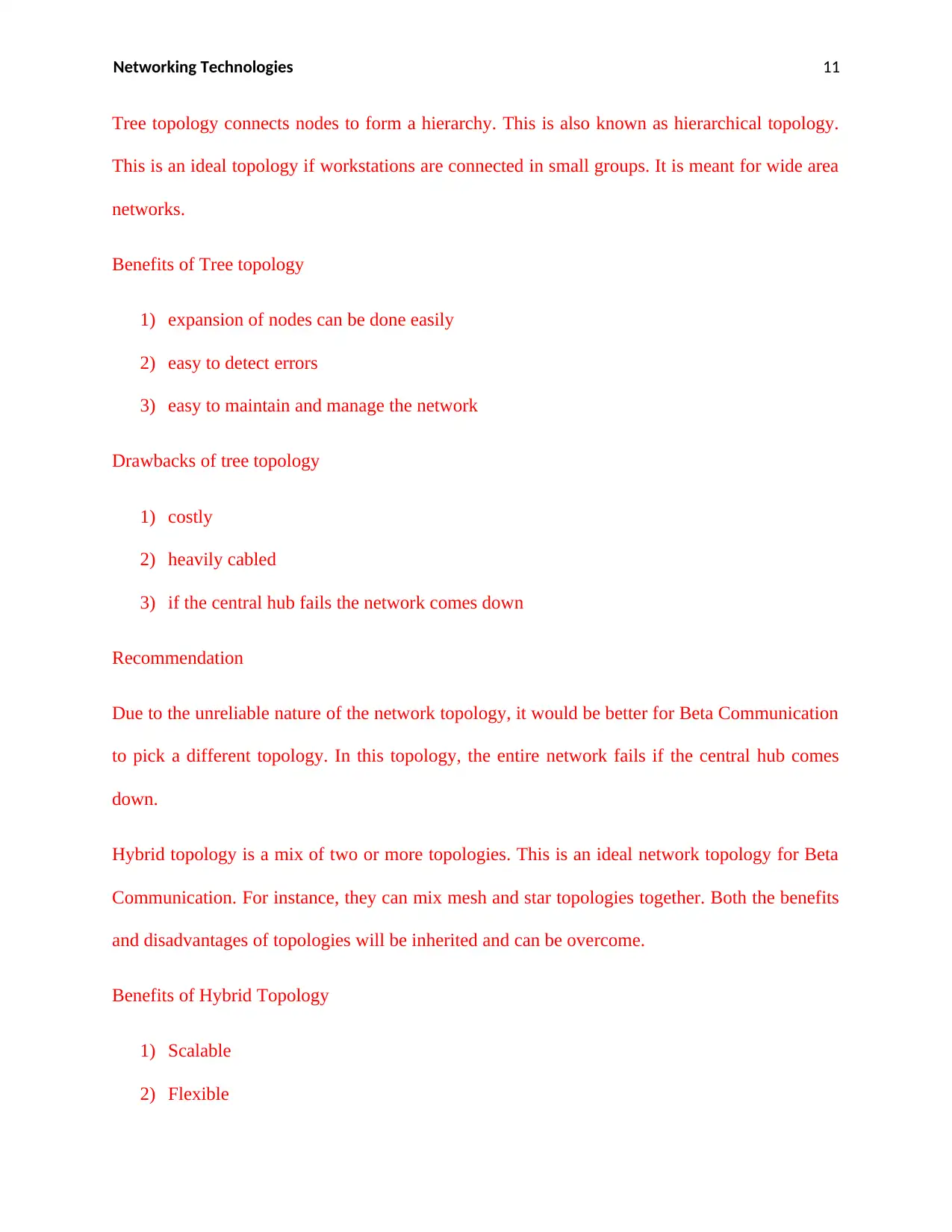
Networking Technologies 11
Tree topology connects nodes to form a hierarchy. This is also known as hierarchical topology.
This is an ideal topology if workstations are connected in small groups. It is meant for wide area
networks.
Benefits of Tree topology
1) expansion of nodes can be done easily
2) easy to detect errors
3) easy to maintain and manage the network
Drawbacks of tree topology
1) costly
2) heavily cabled
3) if the central hub fails the network comes down
Recommendation
Due to the unreliable nature of the network topology, it would be better for Beta Communication
to pick a different topology. In this topology, the entire network fails if the central hub comes
down.
Hybrid topology is a mix of two or more topologies. This is an ideal network topology for Beta
Communication. For instance, they can mix mesh and star topologies together. Both the benefits
and disadvantages of topologies will be inherited and can be overcome.
Benefits of Hybrid Topology
1) Scalable
2) Flexible
Tree topology connects nodes to form a hierarchy. This is also known as hierarchical topology.
This is an ideal topology if workstations are connected in small groups. It is meant for wide area
networks.
Benefits of Tree topology
1) expansion of nodes can be done easily
2) easy to detect errors
3) easy to maintain and manage the network
Drawbacks of tree topology
1) costly
2) heavily cabled
3) if the central hub fails the network comes down
Recommendation
Due to the unreliable nature of the network topology, it would be better for Beta Communication
to pick a different topology. In this topology, the entire network fails if the central hub comes
down.
Hybrid topology is a mix of two or more topologies. This is an ideal network topology for Beta
Communication. For instance, they can mix mesh and star topologies together. Both the benefits
and disadvantages of topologies will be inherited and can be overcome.
Benefits of Hybrid Topology
1) Scalable
2) Flexible
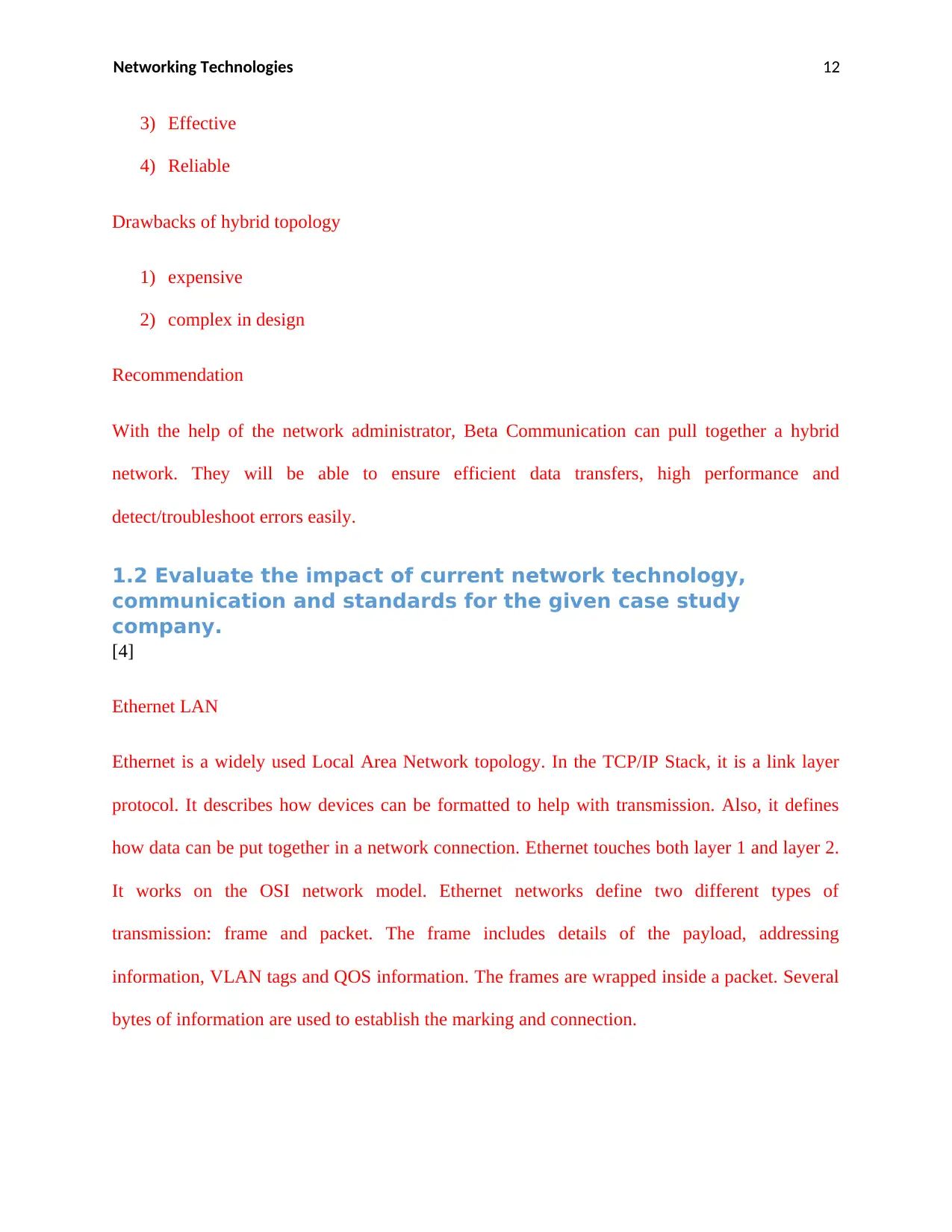
Networking Technologies 12
3) Effective
4) Reliable
Drawbacks of hybrid topology
1) expensive
2) complex in design
Recommendation
With the help of the network administrator, Beta Communication can pull together a hybrid
network. They will be able to ensure efficient data transfers, high performance and
detect/troubleshoot errors easily.
1.2 Evaluate the impact of current network technology,
communication and standards for the given case study
company.
[4]
Ethernet LAN
Ethernet is a widely used Local Area Network topology. In the TCP/IP Stack, it is a link layer
protocol. It describes how devices can be formatted to help with transmission. Also, it defines
how data can be put together in a network connection. Ethernet touches both layer 1 and layer 2.
It works on the OSI network model. Ethernet networks define two different types of
transmission: frame and packet. The frame includes details of the payload, addressing
information, VLAN tags and QOS information. The frames are wrapped inside a packet. Several
bytes of information are used to establish the marking and connection.
3) Effective
4) Reliable
Drawbacks of hybrid topology
1) expensive
2) complex in design
Recommendation
With the help of the network administrator, Beta Communication can pull together a hybrid
network. They will be able to ensure efficient data transfers, high performance and
detect/troubleshoot errors easily.
1.2 Evaluate the impact of current network technology,
communication and standards for the given case study
company.
[4]
Ethernet LAN
Ethernet is a widely used Local Area Network topology. In the TCP/IP Stack, it is a link layer
protocol. It describes how devices can be formatted to help with transmission. Also, it defines
how data can be put together in a network connection. Ethernet touches both layer 1 and layer 2.
It works on the OSI network model. Ethernet networks define two different types of
transmission: frame and packet. The frame includes details of the payload, addressing
information, VLAN tags and QOS information. The frames are wrapped inside a packet. Several
bytes of information are used to establish the marking and connection.
⊘ This is a preview!⊘
Do you want full access?
Subscribe today to unlock all pages.

Trusted by 1+ million students worldwide
1 out of 38
Related Documents
Your All-in-One AI-Powered Toolkit for Academic Success.
+13062052269
info@desklib.com
Available 24*7 on WhatsApp / Email
![[object Object]](/_next/static/media/star-bottom.7253800d.svg)
Unlock your academic potential
Copyright © 2020–2025 A2Z Services. All Rights Reserved. Developed and managed by ZUCOL.





